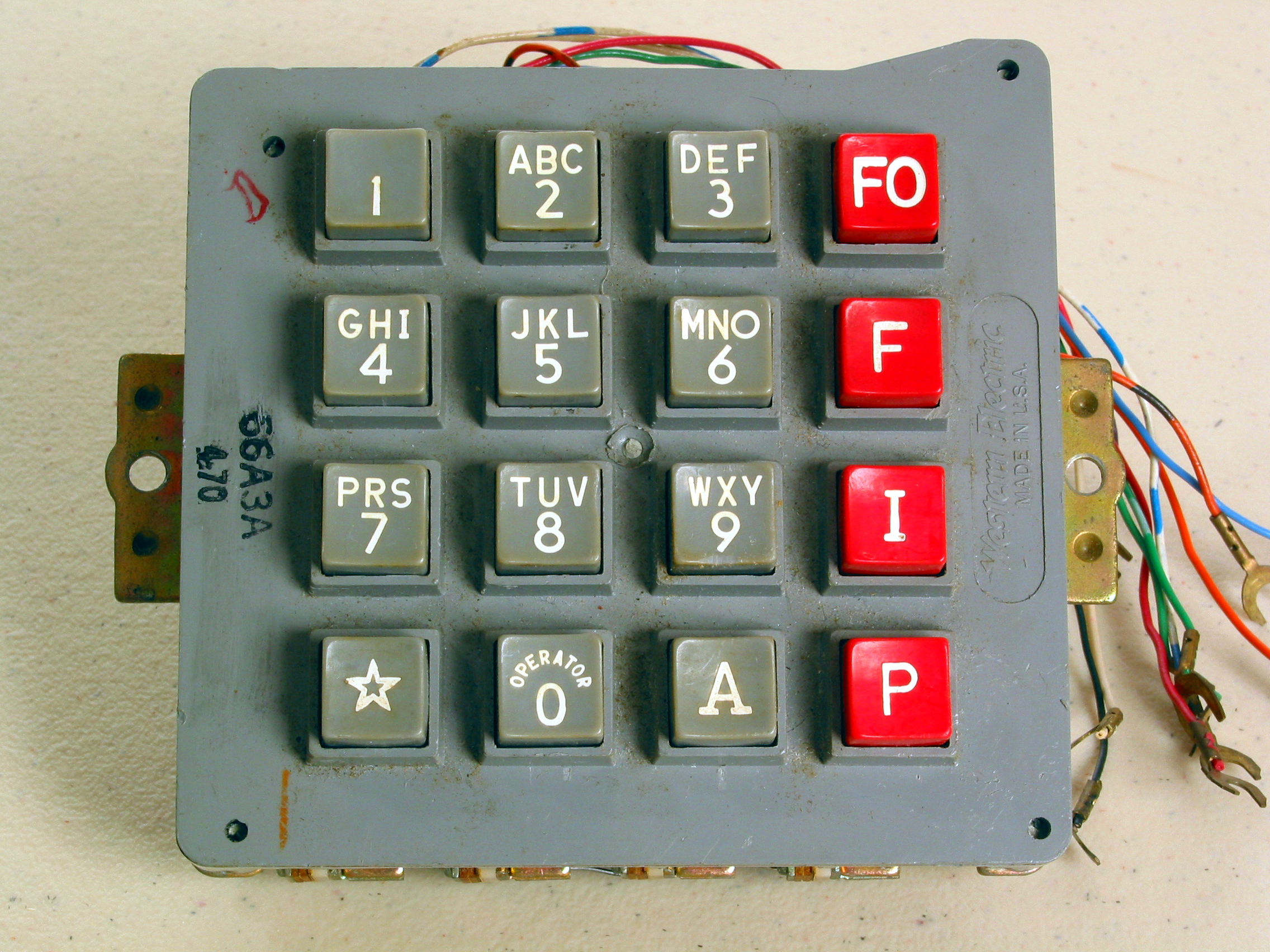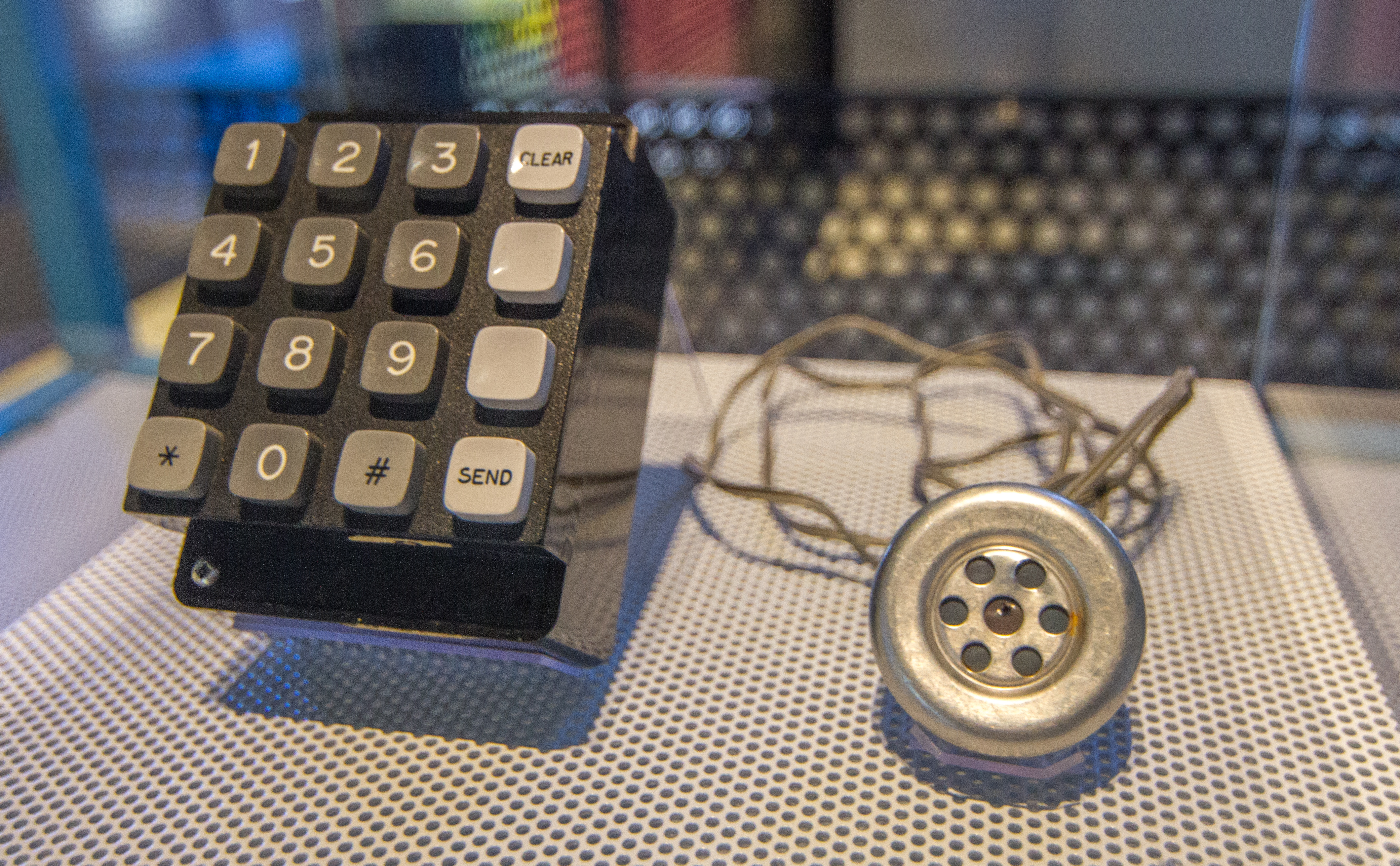|
In-band
In telecommunications, in-band signaling is the sending of control information within the same band or channel used for data such as voice or video. This is in contrast to out-of-band signaling which is sent over a different channel, or even over a separate network. In-band signals may often be heard by telephony participants, while out-of-band signals are inaccessible to the user. The term is also used more generally, for example of computer data files that include both literal data, and metadata and/or instructions for how to process the literal data. Telephony When dialing from a land-line telephone, the telephone number is encoded and transmitted across the telephone line in form of dual-tone multi-frequency signaling (DTMF). The tones control the telephone system by instructing the telephone switch where to route the call. These control tones are sent over the same channel, the copper wire, and in the frequency range (300 Hz to 3.4 kHz) as the audio of the tel ... [...More Info...] [...Related Items...] OR: [Wikipedia] [Google] [Baidu] |
Out-of-band Signaling
In telecommunication, signaling is the use of signals for controlling communications. This may constitute an information exchange concerning the establishment and control of a telecommunication circuit and the management of the network. Classification Signaling systems may be classified based on several principal characteristics. In-band and out-of-band signaling In the public switched telephone network (PSTN), in-band signaling is the exchange of call control information within the same physical channel, or within the same frequency band, that the telephone call itself is using. An example is dual-tone multi-frequency signaling (DTMF), which is used on most telephone lines to customer premises. Out-of-band signaling is telecommunication signaling on a dedicated channel separate from that used for the telephone call. Out-of-band signaling has been used since Signaling System No. 6 (SS6) was introduced in the 1970s, and also in Signalling System No. 7 (SS7) in 1980 which ... [...More Info...] [...Related Items...] OR: [Wikipedia] [Google] [Baidu] |
Control Signal
In telecommunication, signaling is the use of signals for controlling communications. This may constitute an information exchange concerning the establishment and control of a telecommunication circuit and the management of the network. Classification Signaling systems may be classified based on several principal characteristics. In-band and out-of-band signaling In the public switched telephone network (PSTN), in-band signaling is the exchange of call control information within the same physical channel, or within the same frequency band, that the telephone call itself is using. An example is dual-tone multi-frequency signaling (DTMF), which is used on most telephone lines to customer premises. Out-of-band signaling is telecommunication signaling on a dedicated channel separate from that used for the telephone call. Out-of-band signaling has been used since Signaling System No. 6 (SS6) was introduced in the 1970s, and also in Signalling System No. 7 (SS7) in 1980 which becam ... [...More Info...] [...Related Items...] OR: [Wikipedia] [Google] [Baidu] |
Dual-tone Multi-frequency Signaling
Dual-tone multi-frequency signaling (DTMF) is a telecommunication signaling system using the voice-frequency band over telephone lines between telephone equipment and other communications devices and switching centers. DTMF was first developed in the Bell System in the United States, and became known under the trademark Touch-Tone for use in push-button telephones supplied to telephone customers, starting in 1963. DTMF is standardized as ITU-T Recommendation Q.23. It is also known in the UK as ''MF4''. The Touch-Tone system using a telephone keypad gradually replaced the use of rotary dial and has become the industry standard for landline and mobile service. Other multi-frequency systems are used for internal signaling within the telephone network. Multifrequency signaling Before the development of DTMF, telephone numbers were dialed by users with a loop-disconnect (LD) signaling, more commonly known as pulse dialing (dial pulse, DP) in the United States. It functions by ... [...More Info...] [...Related Items...] OR: [Wikipedia] [Google] [Baidu] |
Guard Tone
Guard tone is a feature of wireline modems. The guard tone is sent by the answering modem after it has sent the answer tone. It is a single continuous tone with a frequency of either 1800 Hz or 550 Hz, sent at a level of -6dB or -3dB, respectively, below the level of the transmitted data signal power. It is used with V.22 and V.22bis modulation modes to prevent the high-band data signal from interfering with the operation of billing apparatus in certain countries where in-band signalling was commonplace in the 20th century. 1800 Hz is used in the UK and some Commonwealth countries, while 550 Hz is used in some Scandinavian countries. Guard tones are not used in North America. The guard tone is controlled by the AT command of the Hayes command set. North American Bell 103-style modems (300 bit/s) were incompatible with UK in-band signalling (the modem tones would disconnect the call) unless a guard tone is provided. Most of these (now-obsolete) modems did ... [...More Info...] [...Related Items...] OR: [Wikipedia] [Google] [Baidu] |
Blue Box
A blue box is an electronic device that produces tones used to generate the in-band signaling tones formerly used within the North American long-distance telephone network to send line status and called number information over voice circuits. This allowed the user, referred to as a " phreaker", to surreptitiously place long-distance calls that would be billed to another number or dismissed entirely as an incomplete call. A number of similar "color boxes" were also created to control other aspects of the phone network. First developed in the 1960s and used by a small phreaker community, the introduction of low-cost microelectronics in the early 1970s greatly simplified these devices to the point where they could be constructed by anyone reasonably competent with a soldering iron or breadboard construction. Soon after, models of relatively low quality were being offered fully assembled, but these generally required tinkering on the part of the user to keep operational. An except ... [...More Info...] [...Related Items...] OR: [Wikipedia] [Google] [Baidu] |
Phreaking
Phreaking is a slang term coined to describe the activity of a culture of people who study, experiment with, or explore telecommunication systems, such as equipment and systems connected to public telephone networks. The term ''phreak'' is a sensational spelling of the word '' freak'' with the ''ph-'' from ''phone'', and may also refer to the use of various audio frequencies to manipulate a phone system. ''Phreak'', ''phreaker'', or ''phone phreak'' are names used for and by individuals who participate in phreaking. The term first referred to groups who had reverse engineered the system of tones used to route long-distance calls. By re-creating these tones, phreaks could switch calls from the phone handset, allowing free calls to be made around the world. To ease the creation of these tones, electronic tone generators known as blue boxes became a staple of the phreaker community. This community included future Apple Inc. cofounders Steve Jobs and Steve Wozniak. The blue b ... [...More Info...] [...Related Items...] OR: [Wikipedia] [Google] [Baidu] |
Telecommunications
Telecommunication is the transmission of information by various types of technologies over wire, radio, optical, or other electromagnetic systems. It has its origin in the desire of humans for communication over a distance greater than that feasible with the human voice, but with a similar scale of expediency; thus, slow systems (such as postal mail) are excluded from the field. The transmission media in telecommunication have evolved through numerous stages of technology, from beacons and other visual signals (such as smoke signals, semaphore telegraphs, signal flags, and optical heliographs), to electrical cable and electromagnetic radiation, including light. Such transmission paths are often divided into communication channels, which afford the advantages of multiplexing multiple concurrent communication sessions. ''Telecommunication'' is often used in its plural form. Other examples of pre-modern long-distance communication included audio messages, such as code ... [...More Info...] [...Related Items...] OR: [Wikipedia] [Google] [Baidu] |
Local Insertion
In broadcasting, local insertion (known in the United Kingdom as an opt-out) is the act or capability of a broadcast television station, radio station or cable system to insert or replace part of a network feed with content unique to the local station or system. Most often this is a station identification (required by the broadcasting authority such as the U.S. Federal Communications Commission), but is also commonly used for television or radio advertisements, or a weather or traffic report. A digital on-screen graphic ("dog" or "bug"), commonly a translucent watermark, may also be keyed (superimposed) with a television station ID over the network feed using a character generator using genlock. In cases where individual broadcast stations carry programs separate from those shown on the main network, this is known as regional variation (in the United Kingdom) or an opt-out (in Canada and the United States). Automated local insertion used to be triggered with in-band sign ... [...More Info...] [...Related Items...] OR: [Wikipedia] [Google] [Baidu] |
R2 Signalling
Signalling System R2 is a signalling protocol for telecommunications that was in use from the 1960s mostly in Europe, and later also in Latin America, Asia, and Australia, to convey exchange information between two telephone switching systems for establishing a telephone call via a telephone trunk.ITU-T Recommendation Q.400-Q.490 - Specifications of Signalling System R2 It is suitable for signaling on analog as well as digital circuits. R2 signaling specifications were first published by the International Telegraph and Telephone Consultative Committee (CCITT) in ITU White Book Volume VI of 1969,IVth Plenary Assembly (Mar Del Plata, 23 September-25 October 1968), White Book Volume VI, ''Telephone Signaling and Switching'', Recommendations Series Q, ITU 1969. and are maintained by the |
Escape Sequence
In computer science, an escape sequence is a combination of characters that has a meaning other than the literal characters contained therein; it is marked by one or more preceding (and possibly terminating) characters. Examples * In C and many derivative programming languages, a string escape sequence is a series of two or more characters, starting with a backslash \. ** Note that in C a backslash immediately followed by a newline does not constitute an escape sequence, but splices physical source lines into logical ones in the second translation phase, whereas string escape sequences are converted in the fifth translation phase. ** To represent the backslash character itself, \\ can be used, whereby the first backslash indicates an escape and the second specifies that a backslash is being escaped. ** A character may be escaped in multiple different ways. Assuming ASCII encoding, the escape sequences \x5c (hexadecimal), \\, \134 (octal) and \x5C all encode the same character: ... [...More Info...] [...Related Items...] OR: [Wikipedia] [Google] [Baidu] |
Pulse-code Modulation
Pulse-code modulation (PCM) is a method used to digitally represent sampled analog signals. It is the standard form of digital audio in computers, compact discs, digital telephony and other digital audio applications. In a PCM stream, the amplitude of the analog signal is sampled regularly at uniform intervals, and each sample is quantized to the nearest value within a range of digital steps. Linear pulse-code modulation (LPCM) is a specific type of PCM in which the quantization levels are linearly uniform. This is in contrast to PCM encodings in which quantization levels vary as a function of amplitude (as with the A-law algorithm or the μ-law algorithm). Though ''PCM'' is a more general term, it is often used to describe data encoded as LPCM. A PCM stream has two basic properties that determine the stream's fidelity to the original analog signal: the sampling rate, which is the number of times per second that samples are taken; and the bit depth, which determines t ... [...More Info...] [...Related Items...] OR: [Wikipedia] [Google] [Baidu] |


